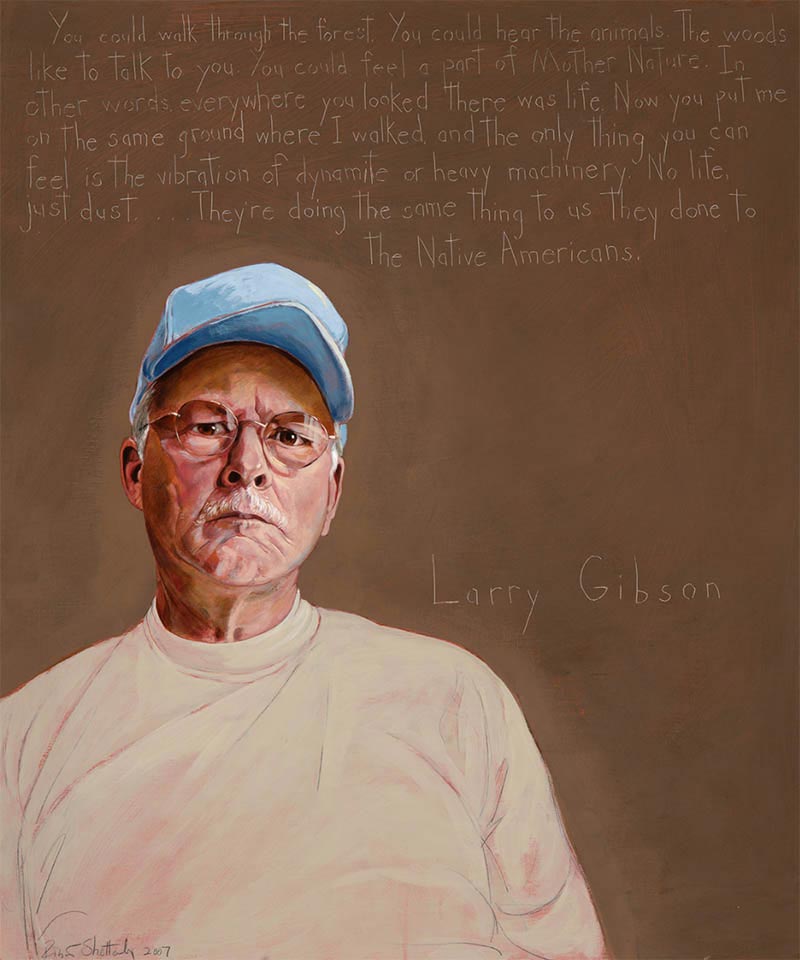
Larry Gibson
Environmental Activist against Mountaintop Removal : 1946 - 2012
“You could walk through the forest. You could hear the animals. The woods like to talk to you. You could feel a part of Mother Nature. In other words, everywhere you looked there was life. Now you put me on the same ground where I walked, and the only thing you can feel is the vibration of dynamite or heavy machinery. No life, just dust. . . . They’re doing the same thing to us they done to the Native Americans.”
Biography
Appalachia is not just a beautiful place to visit for ecologists and those hiking the famous Appalachian Trail. It is home to people who have lived, worked and raised families there for generations. It’s an area rich with forests, birds, fish-filled streams, and coal.
Once, mining underground for coal provided a livelihood for residents of these communities. As that traditional form of mining has given way to mountaintop removal, which requires fewer workers, the economy and the environment of Appalachia´s rural towns have been permanently damaged.
Mountaintop removal uses explosives to slice off the tops of mountains. The seams of coal are then extracted and processed, with the waste and toxins dumped into the valleys and streams as “fill.” People like Larry Gibson, who never would have been activists until their home places were destroyed, called attention to the tragedy, fighting to end the practice of mountaintop removal.
Larry Gibson’s family has lived on Kayford Mountain in West Virginia for generations. By the 1990s, the property he owned, a few acres with several small buildings and the family cemetery, was the only green spot in an otherwise desolate landscape. He refused to sell his property to a company and leave his home, though his land had rich beds of coal beneath it. This refusal came at a cost. Believing that Gibson’s decision not to sell was an attempt to put them out of work, miners shot at his home (visitors can see the bullet holes), and set fire to another building. Two of his dogs were killed, and he was run off the road in his truck. The stress of living in these conditions took a toll on his marriage; still, he wouldn’t give in, saying, “If I stopped fighting for the land, maybe we’d have a chance. But this is my heritage. How can I walk away from that?”
And so he stayed. For more than two decades, his property was a destination for thousands of journalists and environmental activists who wanted to see first-hand the devastating results of mountaintop removal. Seeing the green swath of Gibson´s property set against the vast gray wasteland was something coal companies didn’t want outsiders to witness. Gibson also organized the Keeper of the Mountains Foundation, testified before the United Nations, staged protests, and spoke about mountaintop removal throughout the country. According to The Washington Post, “[h]e was awkward when he first began to speak in public in the 1980s, but he soon became a powerful voice and was known to environmental advocates throughout the country. . . . ‘He’s authentic, he’s real.’”
Gibson continued the fight until his death, in 2012, always working to increase awareness and create change. “I’ve never met a braver man,” said Rob Perks, who formerly ran a campaign against mountaintop removal at the Natural Resources Defense Council. “He’s the one most responsible for getting ingrained in people’s minds what mountaintop removal is all about. He’s like Gandhi for this movement, he really is.”
Programs
Americans Who Tell the Truth (AWTT) offers a variety of ways to engage with its portraits and portrait subjects. Host an exhibit, use our free lesson plans and educational programs, or engage with a member of the AWTT team or portrait subjects.

Education
AWTT has educational materials and lesson plans that ask students to grapple with truth, justice, and freedom.

Exhibits & Community Engagement
AWTT encourages community engagement programs and exhibits accompanied by public events that stimulate dialogue around citizenship, education, and activism.